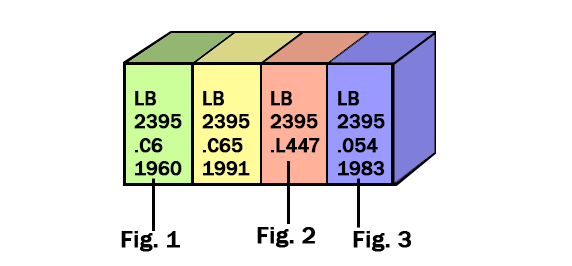Finding Books Using Library of Congress Classification
How Call Numbers Work

- Figure 1
- Books are shelved alphabetically by the first letter or letters.
- Figure 2
- Books are then arranged numerically by the number following the letter(s).
- Figure 3
- Finally, books are shelved alphabetically by the next letter and decimally by the following number.
What does the call number mean?
The Library of Congress Classification arranges materials by subjects. The first sections of the call number represent the subject of the book. The letter-and-decimal section of the call number often represents the author's last name. And, as you recall, the last section of a call number is often the date of publication. example:

- Figure 1
- Book's title: What You Need to Know About Developing Study Skills, Taking Notes & Tests, Using Dictionaries & Libraries.
- Author: Coman, Marcia J.
- Call number: LB2395 .C65 1991
- Figure 2
- The first two lines describe the subject of the book, LB 2395 = Methods of Study, in Higher Education.
- Figure 3
- This line often represents author's last name. .C65 = Coman
Because books are classified by subject, you can often find several helpful books on the same shelf, or nearby. For example, within the same call number LB2395, there are other guides for college study.

- Figure 1
- A Student's Guide to Efficient Study, by Luella Cole.
- Figure 2
- Keys to College Success, by Minnette Lenier.
- Figure 3
- A Successful Student's Handbook, by Rita Phipps.
A Brief Outline of Library of Congress Classification
A-AZ General Works
Encyclopedias, almanacs, general indexes
B-BX Philosophy, Psychology, Religion
BD Philosophy
BF Psychology
BL-BX Religion
C-CT Auxiliary Sciences of History
CC Archaeology
CS Genealogy
CT Biography
D-DX General and Old World History
Includes geography and description of regions and countries
DA-DR EuropeDK Soviet Union
DS Asia
DT Africa
E-F History: Americas
E North American
F United States local history, Latin America
G-GV Geography, Anthropology, Recreation
G Geography, atlases
GE Environmental sciences
GN Anthropology
GR Folklore
GV Sports, dance, games
H-HX Social Sciences
H General social sciences
HA Statistics
HB Economics
HC Economic conditions
HD Industry, labor
HE Transportation, communication
HF Business, commerce
HG Finance
HM Sociology
HQ Family, marriage, aged, women, sexuality
HT Communities, cities, races
HV Criminology, drug abuse
HX Socialism, communism, anarchism, utopias
J Political Science
JF Constitutional history
JK United States
JS Local government
JX International law, world peace
K Law
KF United States law
KFC California law
L Education
M Music
N-NX Art
NA Architecture
NB Sculpture
NC Drawing, design, illustration
ND Painting
NK Arts, crafts
P-PZ Language and Literature
P Philology, linguistics, communication
PA Classical languages, literature
PC Romance languages, literature
PE English dictionaries, thesauri
PF German, Dutch
PG Russian
PL Far eastern languages
PN Drama, poetry, radio broadcasts, movies, television, journalism
PQ Romance literature
PR English literature
PS American literature
PZ Fiction in English
Q-QR Science
Q General science
QA Mathematics, computer science
QB Astronomy
QC Physics
QD Chemistry, biochemistry
QE Geology
QH Natural history
QK Botany
QL Zoology
R Medicine
RA Public aspects of medicine
RC Practice of medicine
RD Surgery
RJ Pediatrics
RM Therapeutics, drugs
RS Pharmacy
S-SK Agriculture
SB Plant culture
SD Forestry
T-TX Technology
TA Engineering
TL Motor vehicles, aeronautics
TR Photography
TX Home economics
U Military Science
V Naval Science
Z Bibliography, library science
A fuller description of the classification system is available from the Library of Congress.
This page was compiled from guides created by the University of Maryland and the University of Hawaii.